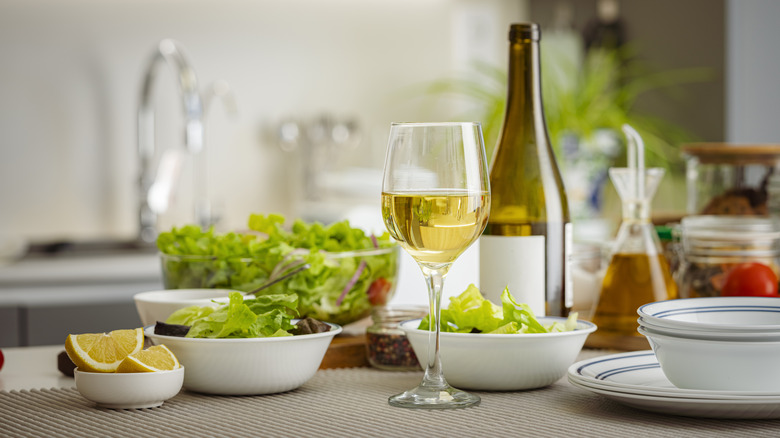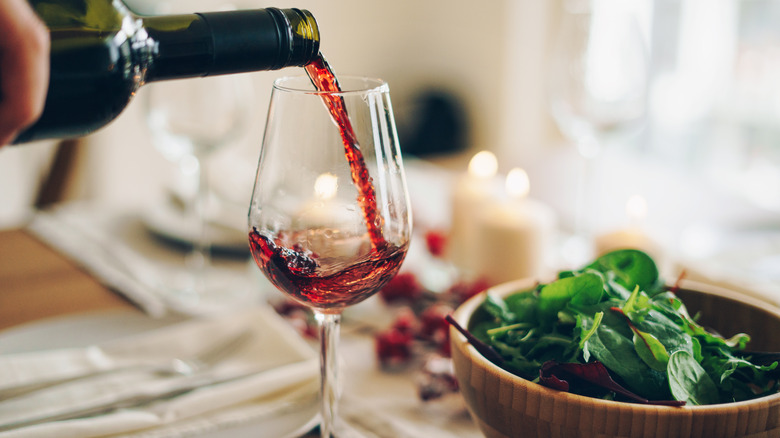What To Consider When Pairing Wine With Your Salad
When it comes to wine pairings, there are a few easy ones. If you didn't already know, you could probably guess that a well-rounded cabernet sauvignon goes well with steak, Champagne is a must for salty oysters and caviar, and the sweetness of an off-dry Riesling can perfectly balance out your spicy Thai takeout. But we understand if you're completely stuck on what kind of wine to serve with salad. Salads are inherently heterogeneous mixtures of different textures and strong flavors. Matching wine to salad is not as straightforward as pairing wine with a single, main protein.
There is a lot of variation from one salad to the next (they can contain almost anything, after all), but a good rule of thumb is to make sure your wine choice can stand up to the flavors and textures in the salad. Often, the key in wine pairing is the opposite — break up heavy, fatty foods with a wine that's tart and light, for instance — but in this case, your best bet is to go matchy-matchy.
To pick the right wine to go with a big salad, think about what kind of flavors the salad will have. Are there briny olives? Sweet berries or candied nuts? Is the dressing creamy, or more vinegar-forward? Once you've identified the flavors at hand, you'll know what to look for in a wine.
Dressed to the nines
Arguably the most important part of a salad, flavor-wise, is the dressing. It is a condiment, but in many cases, it's the main determinant of how the salad will taste overall. Many salad dressings are, at their base, a mixture of oil and vinegar, and thanks to that vinegar, these dressings tend to be rather acidic. Food experts say the trick here is to lean into that acidity rather than trying to combat it.
"The main concern here is making sure that the acid in the wine meets or exceeds the acidity in the salad dressing," Mia Van De Water, sommelier at North End Grill in New York City, said (via Serious Eats). If either the dressing or the wine is significantly more tart or sharp than the other, it's going to overpower the milder one. Don't worry about all of this equating to too much acidity in total, just be sure the other elements of the salad balance out the dressing with contrastingly mild, fatty flavors.
If you've chosen a creamy dressing instead, a similar principle applies: Find a wine with enough body to stand up to a heavier dressing like a bleu cheese or creamy Italian. Put down the zingy summer sippers and look for a wine with a little more body. Oaked chardonnays, for instance, often have rich, almost buttery notes, and drinking one alongside a ranch-topped salad won't make either one pale in comparison to the other.
The sweetest (or most herbaceous) thing
Of course, there's more to salad than dressing. Consider what other ingredients are featured flavors in your salad. If you're making a salad that's savory but also contains fruit, there's going to be some sweetness on your plate. The same goes if you're using candied or honey-roasted nuts or any other distinctly sugary-tasting ingredient. Salads with sweet elements call for sweeter wines. Sometimes a wine guide or the flavor notes on a bottle's label will reference "residual sugars," which refers to any sugars that weren't converted into alcohol during the fermentation process and therefore are still present. If a wine is said to have a fair amount of residual sugar, that's a good indicator that it's going to be on the sweet side (and have a lower alcohol content, too).
If you're making a classic garden salad, dominated by vegetables and herbs, look for wines that have similar flavor profiles. Experts will generally point you toward wines that are light in body and crisp in taste. Now is your favorite warm-weather white's time to shine, or you could even break out a sparkling wine. The effervescence will mirror the refreshing crunch of raw veggies. Grüner Veltliner is a popular choice for when you're showcasing the salad's produce and celebrating fresh, green, light flavors. It'll make even the most delicate dinner salad feel indulgent.


